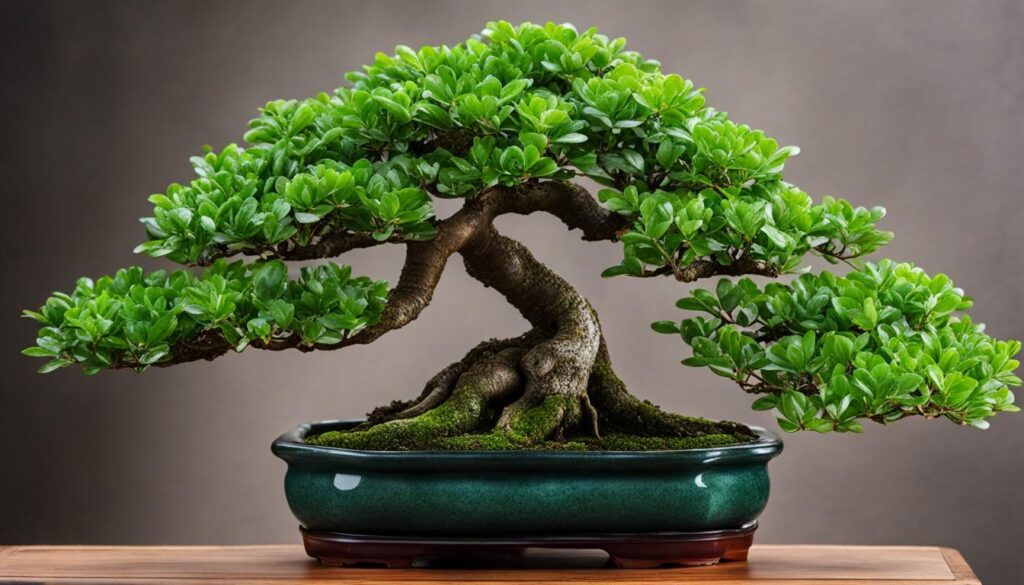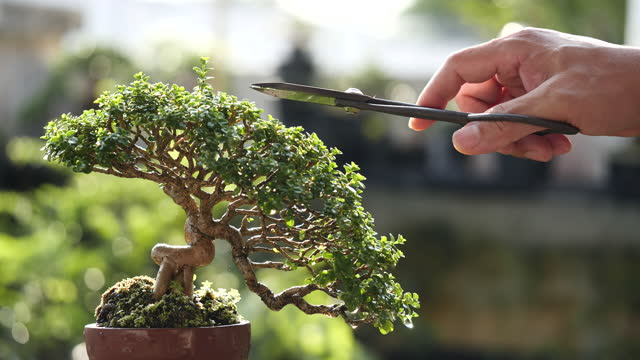With their succulent leaves, jade plant bonsai trees are known for their unique beauty and vibrant energy and fast growth. In this guide, we will take you through every aspect of its care and cultivation, starting from understanding the distinctive features of Crassula ovata to mastering bonsai pruning and styling techniques.
By the end of this guide, you will have the knowledge and skills to nurture a thriving and visually stunning jade bonsai. Let’s dive into the world of jade bonsai and unlock the secrets of successful bonsai cultivation.
Understanding Jade Bonsai (Crassula ovata) Fundamentals

In this section, we will delve into the fundamentals of Jade plant (Crassula ovata). You will learn about the origin and distinctive features of Crassula ovata, including its native habitat and growth habit. We will also compare Crassula ovata with Portulacaria afra to understand their similarities and differences. Additionally, we will explore why Jade is an ideal choice for indoor plant enthusiasts, highlighting its low-maintenance nature and unique beauty.
The Origin and Distinctive Features of Crassula ovata
Jade Bonsai, scientifically known as Crassula ovata, is native to South Africa. It is commonly referred to as the “Jade Plant” or “Money Tree” and has gained popularity among indoor plant enthusiasts due to its attractive appearance and ease of care.
Crassula ovata is characterized by its thick, fleshy, oval-shaped leaves that resemble the shape of jade coins. The leaves can range in color from deep green to a striking jade hue, further enhancing its association with wealth and prosperity. The plant has a natural bonsai-like growth habit, with a thick trunk that develops an aged appearance over time.
One of the distinctive features of Crassula ovata is its ability to store water in its leaves, making it a succulent plant. This adaptive trait allows the Jade Bonsai to withstand periods of drought, making it a resilient and low-maintenance choice for bonsai enthusiasts. Additionally, Crassula ovata produces small, star-shaped pink or white flowers, adding a touch of beauty to its already captivating presence.
Crassula ovata vs. Portulacaria afra: A Comparison
While both Crassula ovata and Portulacaria afra are popular choices for bonsai enthusiasts, there are notable differences between the two species.
| Crassula ovata (Jade Bonsai) | Portulacaria afra |
|---|---|
| Native to South Africa | Native to South Africa and Mozambique |
| Oval-shaped, fleshy leaves | Small, round leaves |
| Thicker trunk, giving it a more “tree-like” appearance | Finer, branching stems, resulting in a more “bush-like” growth habit |
| Leaves vary in color from deep green to jade | Leaves range from bright green to burgundy |
| Slightly more drought-tolerant | More tolerant of regular watering |
While both species have their unique beauty and characteristics, Crassula ovata’s more robust trunk and varied leaf colors make it a preferred choice for bonsai artists seeking a visually striking and versatile specimen.
Why Jade Bonsai is an Ideal Choice for Indoor Plant Enthusiasts
Jade Bonsai holds a special place in the hearts of indoor plant enthusiasts due to its numerous benefits and characteristics. Here’s why Jade Bonsai is an ideal choice:
- Low Maintenance: Jade Bonsai is a hardy plant that requires minimal care, making it perfect for those with busy lifestyles or beginner bonsai enthusiasts.
- Adaptability: Crassula ovata can thrive in a wide range of indoor conditions, including moderate to bright indirect light, average room temperatures, and moderate humidity. This adaptability makes it suitable for various living spaces.
- Aesthetics: The beautiful, oval-shaped leaves and lush green color of Jade Bonsai provide a visually pleasing addition to any indoor setting. Its ability to develop an aged appearance over time adds character and charm to the plant.
- Air Purification: Like other plants, Jade Bonsai helps improve indoor air quality by eliminating toxins and releasing oxygen. This can contribute to a healthier living environment.
- Spiritual Significance: Jade Bonsai is associated with positive energy, prosperity, and good luck in many cultures. Keeping a Jade Bonsai as part of your indoor plant collection can bring a sense of harmony and positivity to your space.
Whether you’re a seasoned bonsai enthusiast looking to expand your collection or a beginner looking for a beautiful and low-maintenance indoor plant, Jade Bonsai (Crassula ovata) offers a captivating choice with its unique characteristics and adaptability.
Cultivating Jade Bonsai: Ideal Varieties for Bonsai Art

When it comes to cultivating Jade Bonsai, selecting the right varieties is essential for bonsai art. Two ideal varieties to consider are Dwarf Jade and Standard Jade. Each variety has its own unique characteristics that contribute to the beauty and appeal of your bonsai collection.
Characteristics of Dwarf Jade vs. Standard Jade Bonsai Varieties
Dwarf Jade (Crassula ovata “Hobbit” or “Gollum”) is a compact variety known for its small, tubular leaves that resemble jade beads. It has a distinctive bonsai appearance with curving branches and a gnarled trunk. The Dwarf Jade Bonsai is a popular choice for beginners due to its adaptability and forgiving nature, making it easier to care for compared to other varieties.
On the other hand, Standard Jade (Crassula ovata “Jade”) is a larger variety with traditional jade plant characteristics. It features round, fleshy leaves and develops a thick, woody trunk over time. The Standard Jade Bonsai offers a more classic bonsai aesthetic, making it a favorite among experienced bonsai enthusiasts.
Selecting the Right Jade Bonsai Specimen for Your Collection
When selecting the right Jade Bonsai specimen for your collection, consider your preferences and goals as a bonsai enthusiast. Assess the desired aesthetic appeal, size, and growth habit of the bonsai tree. Additionally, look for a specimen with a sturdy trunk and well-positioned branches that allow for future styling possibilities.
It is recommended to visit a reputable bonsai nursery or consult with experienced bonsai practitioners who can guide you in choosing the ideal Jade Bonsai specimen based on your specific needs. Remember, selecting the right specimen is crucial for long-term satisfaction and successful cultivation of your bonsai art.
Seasonal Care for Jade Bonsai: Tips for Every Season
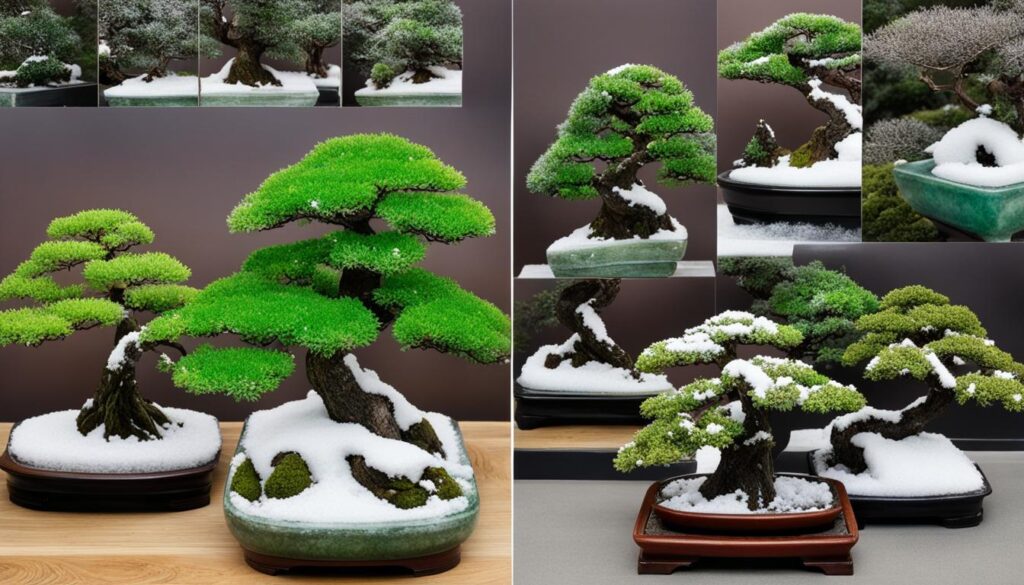
Providing seasonal care is essential for the overall health and development of your Jade Bonsai. To ensure the long-term success of your bonsai tree, it’s important to adapt your care routine to the changing seasons. In this section, we will guide you on specific tips to follow for each season, including adjustments needed for lighting, watering, fertilizing, pruning, and other important aspects of care.
As the seasons change, the needs of your Jade Bonsai will vary. By understanding and addressing these needs, you can create an optimal environment for your bonsai tree to thrive. Below, we provide a comprehensive guide to seasonal care for Jade Bonsai…
“To ensure the long-term success of your Jade Bonsai, it’s important to adapt your care routine to the changing seasons.”
- Spring: In spring, your Jade Bonsai will come out of dormancy and start actively growing. Increase the frequency of watering to meet the increased demands of the growing season. Provide adequate sunlight, but avoid exposing your bonsai tree to direct midday sun to prevent leaf burn. Begin fertilizing with a balanced, slow-release fertilizer to promote healthy growth.
- Summer: During the summer, Jade Bonsai requires more frequent watering due to increased evaporation. Check the moisture level of the soil regularly and water when the top inch feels dry. Protect your bonsai tree from extreme heat by providing shade during the hottest parts of the day. Continue fertilizing with a balanced fertilizer to sustain growth.
- Fall: As the weather cools down, reduce the frequency of watering to prevent overwatering. Gradually reduce fertilization to prepare your Jade Bonsai for dormancy. Protect your bonsai tree from frost by moving it indoors or providing proper insulation. Trim back any overgrown branches to maintain a neat and compact shape.
- Winter: During the winter, your Jade Bonsai will enter a period of dormancy. Reduce watering significantly to prevent root rot. Place your bonsai tree in a cool location where the temperature remains above freezing. Protect your Jade Bonsai from freezing temperatures and drafty areas. Limit pruning during this time, as the tree’s energy is focused on survival.
In addition to these seasonal care tips, remember to regularly check for pests and diseases, and address any issues promptly. Monitor the overall health and appearance of your Jade Bonsai throughout the year, making adjustments to your care routine as needed.
By following these seasonal care tips for your Jade Bonsai, you can help ensure the continued growth and beauty of your bonsai tree throughout the year.
Styling Jade Bonsai: Techniques and Inspirations
Creating a visually stunning Jade Bonsai is not just about its health and care, it’s also an opportunity to express your creativity and artistic vision. Styling a Jade Bonsai involves shaping and refining its aesthetics to create a unique and captivating display. In this final section, we will explore various techniques and provide you with inspirations to elevate the beauty of your bonsai tree.
One of the key aspects of styling Jade Bonsai is understanding different bonsai styles. Whether you prefer the formal upright style, the slanting style, or the cascading style, each technique brings its own visual impact. Consider the natural characteristics of your Jade Bonsai, such as its trunk thickness, branch distribution, and leaf size, to determine which style suits it best. Experiment with different styles to find the one that resonates with your personal aesthetic.
Wiring techniques play a crucial role in shaping your Jade Bonsai into desired forms. Use high-quality bonsai wire to gently bend and position branches, creating elegant curves and dynamic silhouettes. Be mindful not to apply excessive pressure or stress to delicate branches to avoid damage. Regularly monitor the wire and remove it promptly once the branch holds its new shape. Take your time and enjoy the process of sculpting your Jade Bonsai into a living work of art.
While exploring styling options and techniques, it’s essential to embrace the unique beauty of your Jade Bonsai. Consider its natural characteristics, such as its thick trunk, glossy leaves, and distinctive branches, when deciding on the styling. Incorporating these features into your design will highlight the inherent elegance of the Jade Bonsai. Remember, your bonsai tree is a living representation of nature’s art, and by enhancing its natural charm, you can create an awe-inspiring display.
The Art of Pruning and Wiring Your Jade Plant Bonsai
Pruning and wiring are crucial techniques for shaping and styling your Jade Bonsai tree. In this section, we will explore the art of pruning to enhance the aesthetic appeal of your bonsai. We will discuss different pruning techniques and when to apply them to achieve the desired look for your Jade Bonsai.
Techniques for Pruning to Enhance Aesthetic Appeal
When it comes to pruning your Jade Bonsai, there are several techniques you can use to enhance its aesthetic appeal. These techniques include:
- Branch Pruning: Trimming unwanted branches to improve the overall structure and balance of your Jade Bonsai.
- Leaf Pruning: Removing excessive leaves to create a more refined and elegant look.
- Apical Pruning: Trimming the topmost part of the tree to encourage lateral growth and create a fuller canopy.
- Thinning: Removing overcrowded foliage to improve airflow and prevent the risk of disease.
By employing these pruning techniques, you can shape your Jade Bonsai to reflect your desired aesthetic vision while maintaining its health and vigour.
Best Practices for Safely Wiring Delicate Jade Bonsai Branches
Wiring is another essential technique in shaping and styling your Jade Bonsai. When wiring delicate branches, it is important to follow some best practices to ensure the safety and well-being of your bonsai tree:
- Use Appropriate Wire: Select a wire that is strong enough to hold the branch in the desired position without causing damage. Copper or aluminum wire is commonly used for Jade Bonsai.
- Protect the Branch: Place a protective barrier, such as a strip of raffia or bonsai tape, between the wire and the branch to prevent wire scarring or damage.
- Bend and Position Carefully: Gently bend the branch to the desired shape, taking care not to exert excessive pressure. Position the branch in a natural and visually appealing way.
- Regularly Check and Adjust: Regularly inspect the wired branches to ensure they are not becoming too tight or causing any discomfort to the tree. Make adjustments as needed.
- Remove the Wire at the Right Time: Once the branch has set in the desired position, remove the wire carefully to avoid any damage to the branch.
By following these best practices, you can safely wire delicate branches of your Jade Bonsai, allowing you to create intricate and breathtaking designs.
| Pruning Techniques | Benefits |
|---|---|
| Branch Pruning | Improves structure and balance |
| Leaf Pruning | Creates a refined and elegant look |
| Apical Pruning | Encourages lateral growth and a fuller canopy |
| Thinning | Improves airflow and prevents disease |
Optimal Placement for Thriving Jade Bonsai
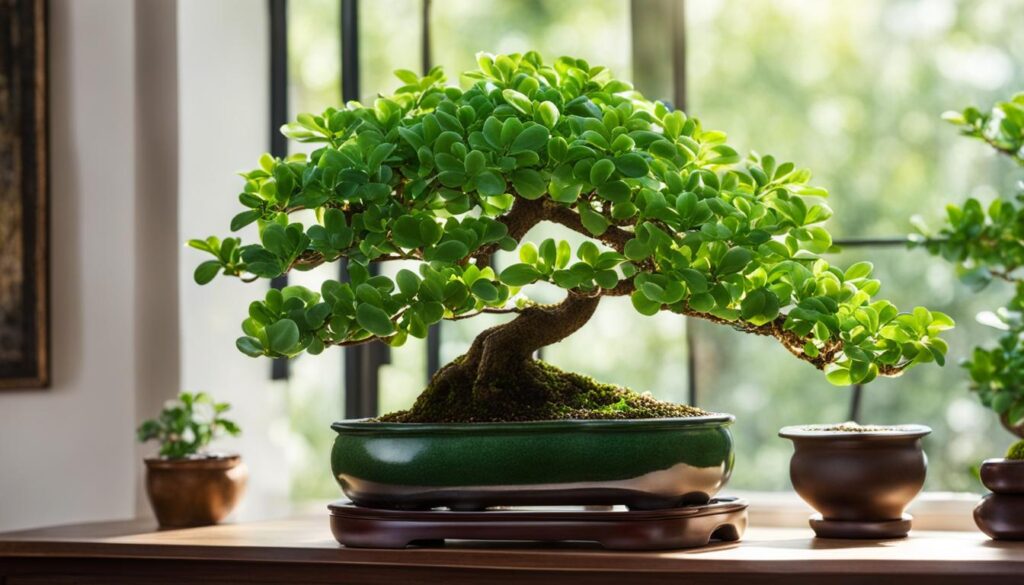
Creating the perfect environment is essential for the thriving growth of your Jade Bonsai. Proper placement plays a crucial role in ensuring the health and beauty of your bonsai tree. Consider the following guidelines to optimize the placement of your Jade Bonsai:
- Lighting conditions: Place your Jade Bonsai in a location that receives bright, indirect sunlight. Avoid direct sunlight, as it can scorch the leaves.
- Temperature requirements: Jade Bonsai prefers moderate temperatures between 65°F and 75°F (18°C – 24°C). Protect your bonsai from extreme temperature fluctuations.
- Humidity levels: Maintain a moderate level of humidity around your Jade Bonsai. You can use a humidity tray or mist the leaves regularly to increase the humidity.
By providing optimal lighting, temperature, and humidity, you can create a favorable environment that promotes the vigorous growth and overall well-being of your Jade Bonsai.
Caring For Jade Bonsai: Watering Dos and Don’ts
Watering is a crucial aspect of caring for Jade Bonsai. Proper watering techniques ensure the optimal health and growth of your bonsai tree. In this section, we will provide you with essential dos and don’ts for watering your Jade Bonsai.
Jade Bonsai has unique water requirements that differ from other plants. Understanding these requirements is key to maintaining a thriving bonsai. Here are some dos and don’ts to keep in mind:
Dos:
- Water your Jade Bonsai when the top inch of the soil feels dry. Insert your finger into the soil to check the moisture level.
- Use room temperature water to avoid shocking the roots.
- Water deeply until the water drains out of the drainage holes, ensuring proper hydration for the entire root system.
- Ensure adequate drainage by using a well-draining bonsai soil mix and a pot with drainage holes. Excess water should freely flow out, preventing waterlogged roots.
Don’ts:
- Overwater your Jade Bonsai. Excess water can lead to root rot and other related problems. It’s important to strike a balance between keeping the soil moist and avoiding waterlogging.
- Water your bonsai on a strict schedule. Factors such as temperature, humidity, and seasonal variations can affect the water requirements of your Jade Bonsai. Adapt your watering routine accordingly.
- Allow your bonsai tree to sit in standing water. This can suffocate the roots and cause irreversible damage.
Remember, the key to successful watering is to observe your Jade Bonsai’s specific needs. Pay attention to the signs of overwatering or underwatering, such as yellowing leaves or wilting. Adjust your watering routine accordingly to ensure your bonsai thrives.
Fertilizing Your Jade Bonsai: A Growth Promoting Practice
Fertilizing is an essential practice for promoting the growth and health of Jade Bonsai. By providing your bonsai tree with the necessary nutrients, you can ensure its overall well-being. In this section, we will guide you on how and when to fertilize your plant to maximize its growth potential.
When it comes to fertilizing Jade Bonsai, it is important to choose the right type of fertilizer. Opt for a balanced fertilizer specifically formulated for bonsai trees, as it will provide the necessary nutrients in the correct proportions.
“Proper fertilizing practices are essential in maintaining the overall health and vigor of your Jade Bonsai.”
The frequency of fertilizer application depends on the specific fertilizer and the needs of your plant. Generally, it is recommended to fertilize every 4-6 weeks during the growing season, which typically extends from spring to early fall. However, be cautious not to over-fertilize, as excessive nutrients can cause root burn and other health issues.
Balance is key when it comes to fertilizing Jade Bonsai. Ensure that your bonsai tree receives a balanced combination of nitrogen (N), phosphorus (P), and potassium (K) to support healthy growth. Nitrogen promotes foliage development, phosphorus enhances root growth and flowering, and potassium improves overall vigor and disease resistance.
| Nutrient | Function | Recommended Ratio |
|---|---|---|
| Nitrogen (N) | Foliage development | 1 |
| Phosphorus (P) | Root growth and flowering | 1/2 |
| Potassium (K) | Vigor and disease resistance | 1/2 |
Remember to follow the instructions provided with the fertilizer to ensure proper application and dosage. Apply the fertilizer evenly across the soil surface, taking care not to concentrate it near the trunk or roots.
In conclusion, fertilizing your Jade Bonsai is a crucial practice that promotes its growth and overall health. By selecting the right fertilizer, applying it at the appropriate frequency, and providing a balanced combination of nutrients, you can ensure your bonsai tree thrives and continues to delight with its beauty.
When and How to Repot Your Jade Bonsai Effectively
Repotting is an essential task for maintaining the health and growth of your Jade Bonsai. It provides an opportunity to refresh the soil, promote root development, and ensure the availability of essential nutrients. In this section, we will guide you on when and how to repot your bonsai tree effectively to keep it thriving.
Knowing when to repot your plant is crucial. Look for the following signs to determine if it’s time for repotting:
- Roots circling the pot
- Slow growth or stunted appearance
- Water draining too quickly or not at all
- Signs of nutrient deficiencies
Once you’ve identified the need for repotting, choose the appropriate timing. Spring is generally the best time for repotting your Jade Bonsai, as it allows the tree to recover during the growing season. Avoid repotting during extreme weather conditions or when your bonsai is weak or stressed.
When repotting your Jade Bonsai, follow these guidelines:
- Carefully remove the bonsai from its current pot.
- Gently comb out the roots to remove old soil and identify any dead or damaged roots.
- Trim back approximately one-third of the root mass, focusing on thicker roots and any circling roots.
- Prepare a well-draining, bonsai-specific soil mix with optimal moisture retention.
- Place a layer of fresh soil in the bottom of the new pot and position the bonsai on top, ensuring it is centered.
- Fill the rest of the pot with soil, gradually working it around and between the roots to eliminate air pockets.
- Water thoroughly until water drains from the bottom of the pot.
After repotting, provide your Jade Bonsai with proper care and monitor its progress. Avoid excessive watering and direct sunlight during the recovery period.
You can refer to the image below for a visual representation of the repotting process:
By following these effective repotting guidelines, you can ensure the continued health and vitality of your Bonsai, allowing it to flourish and thrive in its new pot.
Propagating Jade Bonsai Through Cuttings

Propagating Jade Bonsai through cuttings is a rewarding way to expand your bonsai collection. By following a step-by-step guide to successful propagation, you can unlock the potential of creating new bonsai trees from your existing Jade Bonsai. One key aspect of propagating Jade Bonsai is encouraging healthy root development, which plays a vital role in the growth and longevity of the tree.
Step-by-Step Guide to Successful Jade Bonsai Propagation
- Start by selecting a healthy branch from the Jade Bonsai tree that is suitable for cutting. Ideally, choose a branch that is young and vigorous.
- Using clean and sharp bonsai shears, make a clean diagonal cut just below a leaf node. This will provide the best chance of successful rooting.
- Remove the lower leaves from the cutting, leaving only a few at the top to aid photosynthesis.
- Prepare a well-draining rooting medium, such as a mix of perlite and peat moss, and moisten it slightly.
- Plant the cutting in the rooting medium, burying it about an inch deep. Make sure to keep the medium consistently moist without overwatering.
- Place the cutting in a warm and well-lit location, preferably under indirect sunlight. Avoid exposing the cutting to harsh direct sunlight.
- Maintain a consistent level of humidity around the cutting by covering it with a plastic bag or using a mini greenhouse.
- Monitor the cutting regularly, checking for signs of growth and rooting. Be patient, as it may take several weeks or even months for roots to develop.
- Once the cutting has developed a healthy root system, carefully transplant it into a small bonsai pot, using well-draining bonsai soil.
- Continue caring for the newly propagated Jade Bonsai as you would with any mature bonsai, following the appropriate watering, fertilizing, and pruning guidelines.
With dedication and patience, you can propagate Jade Bonsai through cuttings and witness the growth of new bonsai trees that carry the charm and beauty of their parent plant.
Tips for Encouraging Healthy Root Development
Encouraging healthy root development is essential for the success of propagated Jade Bonsai. Here are some tips to ensure optimal root growth:
- Provide a suitable rooting medium that offers excellent drainage and aeration.
- Maintain consistent moisture levels in the rooting medium without overwatering, as excessive moisture can lead to root rot.
- Place the cutting in a warm and well-lit environment, as higher temperatures encourage root growth.
- Consider using rooting hormone or natural alternatives to stimulate root formation.
- Protect the cutting from extreme weather conditions, such as frost or excessive heat, which can stress the roots.
By implementing these tips, you can create a conducive environment for healthy root development, ensuring the future success of your propagated Jade Bonsai.
Identifying and Addressing Pests and Diseases
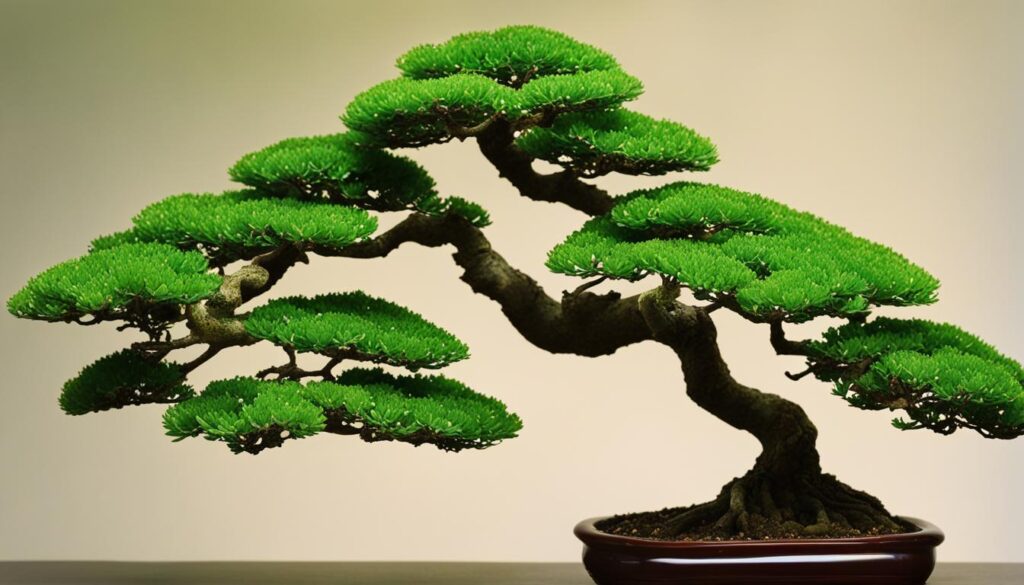
Pests and diseases can pose a significant threat to the health and vitality of your Jade Bonsai. By understanding the common pests and diseases that can affect bonsai trees, including Jade Bonsai, you can take proactive measures to identify and address any issues that may arise.
When it comes to pests, some of the common ones that can target your Jade Bonsai include aphids, spider mites, scale insects, and mealybugs. These pests can cause damage to the leaves, stems, and overall structure of your bonsai tree. Keep a close eye on your Jade Bonsai and look out for signs of infestation, such as discolored or deformed leaves, webs, or the presence of small insects.
To address pest infestations, you can try removing the pests manually by gently wiping them off with a soft cloth or cotton swab. Alternatively, you can use insecticidal soaps or horticultural oils that are specifically formulated for treating pests on bonsai trees. Follow the instructions on the product label and apply the treatment as directed.
When it comes to diseases, root rot and fungal infections are some of the common issues that can affect Jade Bonsai. Overwatering or poor drainage can lead to root rot, while high humidity or improper ventilation can create a favorable environment for fungal infections. Look out for signs of root rot, such as wilting leaves, yellowing or browning of the foliage, and soft or mushy roots. Fungal infections may appear as discolored spots, powdery growth, or lesions on the leaves or stem.
If you suspect that your Jade Bonsai is experiencing root rot, carefully remove it from its pot and examine the roots. Trim away any affected or rotten roots using sterile bonsai tools and repot the tree in fresh, well-draining soil. To address fungal infections, you can apply fungicides specifically formulated for bonsai trees. Follow the instructions on the product label and treat the affected areas accordingly.
Prevention is always key when it comes to maintaining the health of your Jade Bonsai. Regularly inspect your bonsai tree for signs of pests or diseases, and take immediate action if any issues are detected. Additionally, practicing good bonsai care techniques, such as proper watering, adequate ventilation, and maintaining a clean environment, can help prevent the onset of pests and diseases.
By being vigilant and proactive in identifying and addressing pests and diseases, you can ensure the long-term health and vitality of your Jade Bonsai, allowing it to thrive and bring beauty to your bonsai collection,

